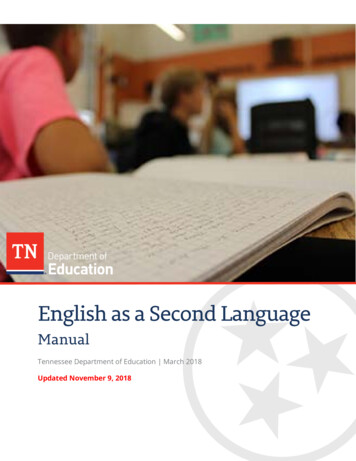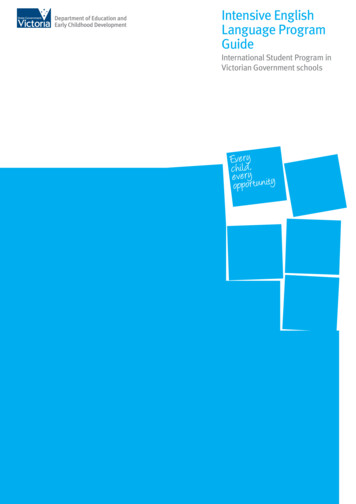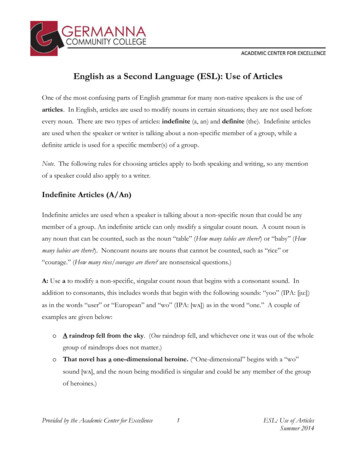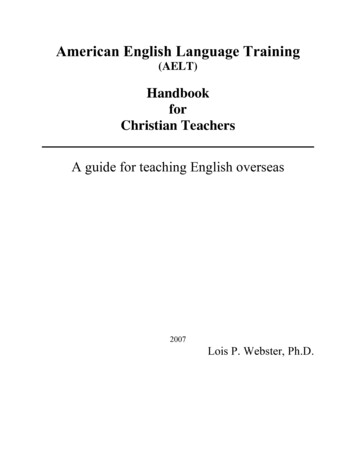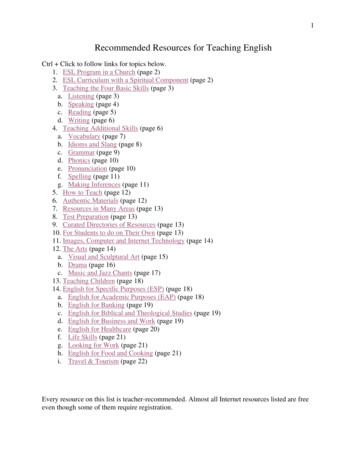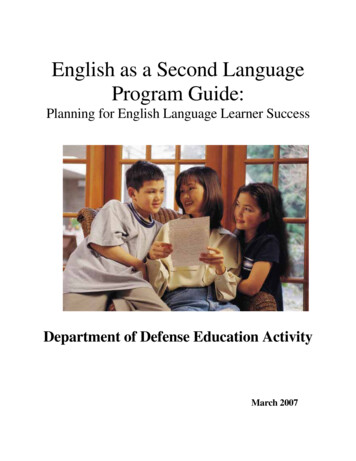
Transcription
English as a Second LanguageProgram Guide:Planning for English Language Learner SuccessDepartment of Defense Education ActivityMarch 2007
This page intentionally left blank
DEPARTMENT OF DEFENSEEDUCATION ACTIVITY4040 NORTH FAIRFAX DRIVEARLINGTON, VA 22203-1635ForewordThis publication offers guidance to administrators and teachers in addressing the linguistic andeducational needs of English language learners by identifying students and developing programs thatrecognize their diverse ethnic and cultural backgrounds and experiences. The information in thisguide is intended to aid teachers and administrators when planning for and providing services toEnglish as a second language students. The information in this guide was updated to reflectresearched best practices and the alignment to national program and English language proficiencystandards. The structure of the guide is intended to follow the sequential approach of identificationof English language learners through program implementation. The guide is designed to be a flexibleworking document, adaptable to changing needs, and produced in loose-leaf format to allow forfuture revisions and additions of clarifying instructions, directives, and/or decisions.This guide applies to all DoDEA personnel, parents, and sponsors and affects the process by whichEnglish language learners in DoDEA receive linguistic and educational support services. This guide,as a statement of policy and administrative guidance, shall not be interpreted to create anysubstantive or procedural legal rights to challenge agency action or inaction. Teachers andadministrators are encouraged to become familiar with and promote the content of this guide and toassure that policy and procedures are consistently followed.The purpose of the English as a Second Language Program Guide: Planning for EnglishLanguage Learner Success, is to provide guidance to DoDEA areas, districts and schools on theimplementation of DoDEA regulation 2440.1, “English as a Second Language Programs,” April,2006. This guide supersedes and cancels DS Manual 2440.2, “English as a Second LanguageProgram”, July 1998 and replaces previous administrative procedures and associated information forthe ESL program. The current revision reflects changes in the provision of services as suggested bythe No Child Left Behind Act of 2001 and in the Office of Civil Rights document, Program forEnglish Language Learners, available on the U.S. Department of Education (USDOE) website:http://www.ed.gov/offices/OCR/ELL/. Further information on legal and judicial matters affectingEnglish language learners can also be found on the USDOE website.
This page intentionally left blank
DoDEA ESL Program Guide, March 2007Table of ContentsFOREWARDPageiTABLE OF CONTENTSiiINTRODUCTIONI-1CHAPTER 1 PROGRAM OVERVIEW1-1Goals of the ESL ProgramESL Program ProceduresESL Student TeamESL Review TeamIdentificationAssessment\ EvaluationEligibilityInstructional ProgramsAnnual Monitoring of Student ProgressAnnual ReportAnnual Program EvaluationESL Program Task TimelineESL Teacher ResponsibilitiesRelationship with HAPTER 2 ESL STUDENT IDENTIFICTION PROCESS2-1Eligibility CriteriaESL Eligibility (Flow Chart)Identification through the Screening ProcessHome Language QuestionnaireThe ESL Referral ProcessHome Language Questionnaire (Flow Chart)Summary of Steps: Home Language QuestionnaireESL Referral Process (Flow Chart)Summary of Steps: Referral ProcessFunctioning Level of Language2-12-32-52-52-52-102-112-132-142-15CHAPTER 3 INSTRUCTIONAL PROGRAM3-1ESL Program Service DeliveryExitingCriteria for Exiting ESL Program3-23-33-4Table of Contentsii
Classroom Support for Small ELL PopulationsESL Recommended Services Guidance3-43-6CHAPTER 4 SYSTEM-WIDE ASSESSMENT4-1AccommodationsClassification of AccommodationsStudents Eligible for AccommodationsSelecting AccommodationsSample Questions for Determining AccommodationsNo AccommodationsESL Alternate AssessmentAlternate Assessment Eligibility CriteriaELL Participation in System-wide Assessment (Flow Chart)ESL Accommodations ChartAccommodations Most Frequently Offered by NAEP4-14-24-34-34-44-54-64-74-84-94-10CHAPTER 5 ANNUAL MONITORING OF STUDENT PROGRESS5-1Procedures for the Annual Monitoring of Student ProgressFrequently Asked Questions5-35-5CHAPTER 6 ANNUAL PROGRAM REVIEW6-1Review of ESL Program6-2CHAPTER 7 ESL AND SPECIAL EDUCATION7-1The Special Education Pre-Referral ProcessSteps in the Pre-Referral ProcessThe Special Education Pre-Referral Process (Flow Chart)Information for the Pre-Referral ProcessInformation for the Pre-Referral Process for A Young ChildFormal Referral to CSCPlanning and Administering AssessmentsAuthentic/Alternative AssessmentIndividual Assessment Reports and ResultsLanguage Proficiency/ DominanceDistinguishing Between Second Language Acquisition andDisability CharacteristicsEligibility for Special Education ServicesIEP DevelopmentCharacteristics of ELL Students With and Without a Disability7-27-37-47-57-67-67-77-87-97-10CHAPTER 8 OTHER SCHOOL PROGRAMS7-107-117-137-158-1
Advanced Placement CoursesAdvancement Via Individual Determination (AVID)Gifted EducationLanguage Arts, Reading, and Mathematics Lab ClassesReading RecoverySure Start8-18-18-28-38-48-5CHAPTER 9 GENERAL INFORMATION9-1Record KeepingTransferring StudentsGradingProgress ReportsRecommendation for General Grade/Program PlacementRetentionDoDEA High School Graduation Requirement9-19-29-29-39-39-49-5APPENDIX A- REQUIRED FORMSGuidelines for the ELL Cumulative Profile Signature PageGuidelines for the ELL Cumulative ProfileELL Cumulative Profile Signature PageELL Cumulative Profile FormParent Notification of ExitingESL Home Language QuestionnaireWaiver of ESL Language Proficiency AssessmentWaiver of ESL ServicesESL ReferralExit from ESL ProgramParent Permission for AssessmentParent Notification and ConsentESL Program Self Study GuideAPPENDIX B- OPTIONAL FORMSParent Notification of ScreeningESL Eligibility ChecklistParent Notification of IneligibilityStudent Home Language Interview QuestionsInvitation to ESL MeetingParent Home Language Interview QuestionsESL Assessment SummaryESL Annual Monitoring of Student Progress Summary FormESL Annual Monitoring of Student Progress Summary Form Guidelines
APPENDIX C- SYSTEM-WIDE ASSESSMENT INFORMATION AND RESOURCES C-1System-Wide Assessment Questions and AnswersQuestions to Help Determine Appropriate AccommodationsC-3C-7APPENDIX D- SPECIAL EDUCATION FREQUENTLY ASKED QUESTIONSD-1APPENDIX E- ESL ALTERNATE ASSESSMENTE-1APPENDIX F- COURSE DESCRIPTIONSF-1English as a Second Language 1 Hour Grades 7- 8ESL Building Language 2 Hours Grade 7- 8ESL Building Communication 2 Hours Grade 5-6ESL Beginning Communication Grades 9-12Entrance to English Grades 9-12ESL Developing Communication Grades 9-12ESL Expanding Communication Grades 9-12ESL Bridging Communication Grades 9-12F-3F-5F-6F-7F-9F-10F-12F-14APPENDIX G- GLOSSARYG-1APPENDIX H- REFERENCESH-1ReferencesDoDEA/Government ReferencesH-3H-6
DoDEA ESL Program Guide, March 2007DoDEAEnglish as a Second Language Program GuideIntroductionDoDEA serves dependents of the Department of Defense military and civilian employees stationedoverseas and in various states and territories within the United States. The DoDEA communityencompasses a diverse population; therefore, a program has been designed to increase Englishlanguage proficiency for students who have a second language influence. DoDEA strives to create alearning environment that encourages assimilation into the second language and culture whilemaintaining respect for and pride in their cultural and linguistic heritage. The English as a SecondLanguage (ESL) program delivers comprehensive instruction so that these students can attain thegoals and outcomes as set forth in the DoDEA Community Strategic Plan. Programs for Englishlanguage learners (ELL) reflect DoDEA’s guiding principles in providing unlimited opportunities toreach high expectations, equal access to quality education based on standards, new and motivatingchallenges to inspire excellence, and total accountability.This publication offers guidance to administrators and teachers in addressing the linguistic andeducational needs of the English language learner by identifying students and developing programsthat recognize their diverse ethnic and cultural backgrounds and experiences. The English as aSecond Language (ESL) program in DoDEA supports research-based best practices and is alignedwith national program and English language proficiency standards. The structure of the guide isintended to follow the sequential approach of identification of English language learners throughprogram implementation.IntroductionI-1
This page intentionally left blank
DoDEA ESL Program Guide, March 2007DoDEAEnglish as a Second Language (ESL) Program GuideChapter 1- Program OverviewDoDEA provides a program for English language learners (ELL) to increase students’ Englishlanguage skills so their academic performance is equivalent to native English-speaking students ofthe same age and grade level. The focus is to provide the educational opportunities that will enablethe ELL to be an independent learner, successful in the classroom, and a productive member ofsociety. The ESL program provides consultation at the pre-kindergarten level and a continuum ofservices from kindergarten through the twelfth grade that develops both Basic InterpersonalCommunication Skills (BICS) and Cognitive Academic Language Proficiency (CALP).The DoDEA Home Language Questionnaire (HLQ), performance on language proficiency andsystem-wide assessments, records reviews, and referrals are used to identify potential studentseligible for the ESL program. These results, along with the student’s academic performance, areused to determine eligibility for program placement and services.Using a variety of program delivery models and providing a continuum of support services, generaleducation and ESL teachers have a shared responsibility to ensure all ELLs reach full educationalparity with their native English-speaking peers, and to provide a language-rich environment thatpromotes high expectations for academic achievement. ELLs are immersed within the generalcurriculum and receive instructional services through support in a collaborative classroom.The DoDEA program for ELLs encompasses both social and academic needs. ELLs can developsocial and academic language at the same time. Emphasis should be placed on supporting thestudent’s performance and mastery of English in the content areas. Learning language through thecontent areas enables the student to acquire age/grade appropriate content standards while developingEnglish language proficiency. While English is the language of instruction, students are encouragedto continue to develop proficiency in their first language as they acquire English. Teachers of ELLsare encouraged to validate the first culture and language by connecting the curriculum with thestudent’s personal experiences while providing a bridge to English proficiency.Goals of the ESL ProgramThe over-all focus of the DoDEA English as a Second Language Program is to provide opportunitiesfor ELLs to reach full parity with their native English-speaking peers. The three broad goals set forthin the Teachers of English to Speakers of Other Languages, 1997 (TESOL) ESL Standards for Pre-Chapter 1 Program Overview1- 1
DoDEA ESL Program Guide, March 2007K- 12 Students provide the foundation for the design of DoDEA’s English as a Second Languageprogram. Through English language instruction, the ELL works toward attainment of these ESLproficiency standards and goals, achievement and realization of long term personal, social, andeconomic success in an English speaking society. The goals are to:1. Use English to communicate effectively in a social setting.a. Use English to participate in social interaction;b. Interact in, through, and with spoken and written English for personal expression andenjoyment; andc. Use learning strategies to extend communicative competence.2. Use English to achieve academic standards in all content areas.a. Use English to interact in the classroom;b. Use English to obtain, process, construct, and provide subject matter information in spokenand written form; andc. Use appropriate learning strategies to construct and apply academic knowledge.3. Use English socially and in culturally appropriate ways.a. Choose appropriate language variety, register, and genre according to audience, purpose andsetting;b. Vary non-verbal communication according to audience, purpose and setting; andc. Use appropriate learning strategies to extend their social-linguistic and social-culturalcompetence.Chapter 1 Program Overview1- 2
DoDEA ESL Program Guide, March 2007DoDEA ESL Program ProceduresThe school’s primary responsibility is to identify all students who qualify for ESL services and toensure they can meaningfully participate in the academic and special programs offered. The initialstep in the implementation and administration of the ESL program is the establishment of an ESLteam that has two primary functions: ESL Student Teams and ESL Review Team. The primaryresponsibilities of the ESL Student Teams are to promote sound educational decisions based on inputfrom a variety of sources for individual ELLs. The ESL Review Team is responsible for promotingan effective ESL program. Identification of potential ELLs is achieved through two avenues: (1) aschool referral process, and (2) the sponsor completing the Home Language Questionnaire. Once thepotential ELL is identified, formal and informal measures are used to determine the student’slanguage proficiency and the need for services. ELLs are assessed annually to document progressand support educational decisions.This section provides schools with the broad view of model standard operating procedures for theadministration and implementation of the DoDEA ESL program. Each key area listed below isexplained in more detail in the following chapters.ESL Student TeamsThe purpose of the team is to make educational decisions regarding ESL student services. The ESLStudent Team focuses on making sound educational decisions for a specific ELL. Membership onthe team is fluid and the composition depends on the activities that must be accomplished by theteam. ESL Student Teams should be comprised of ESL teacher(s) and at least one of the student’sgeneral education teacher(s). The administrator may participate in team meetings, as needed. Otherspecialists serve as consultants, when appropriate. Whenever possible and appropriate, the parentand student may be integral members of the team. A formal meeting of the ESL Student Teammembers is not required. Communication between the ESL Student Team members may beaccomplished informally, as appropriate.The responsibilities of the ESL Student Teams include, but are not limited to: Identifying individual ESL student learning needs.Determining program eligibility.Monitoring individual student language acquisition and academic achievement.Making appropriate instructional recommendations.ESL Review TeamThe purpose of the ESL Review Team is to conduct an annual review of the ESL program for overalleffectiveness and make recommendations for improvement. At minimum, the review team shouldbe comprised of the ESL teacher(s) and general education teacher(s). Other educators, parents andstudents may be included, as appropriate. The administrator in collaboration with the ESL teacherChapter 1 Program Overview1- 3
DoDEA ESL Program Guide, March 2007determines the composition of the other review team members to complete the ESL Self-StudyGuide.The responsibilities of the ESL Review Team include, but are not limited to: Ensuring that systematic procedures and safeguards are in place.Reviewing the ESL program and recommending needed changes.Identification and Referral for Assessment/EvaluationDoDEA has established a uniform procedure for the identification of ELLs. The procedure beginswith the completion of the Home Language Questionnaire (HLQ) or with the submission of areferral.1. Home Language QuestionnaireAll sponsors are asked to complete the Home Language Questionnaire at the time of registrationregardless of the student’s language, race, or ethnicity. A copy of Home LanguageQuestionnaires are provided to the ESL teacher by the school registrar whenever the sponsor hasindicated a language other than English is spoken in the home. The ESL teacher reviews theeducational records of all potential ELLs identified through the Home Language Questionnaire.Based on this review of HLQs, the ESL teacher reviews the records of students with possibleESL needs, compiles a list of all such students, and, if considered necessary, refers the childrenfor assessment/evaluation.2. ReferralA student experiencing academic difficulty may be referred for ESL services by the classroomteacher, the parent, or student self-referral. The referring individual completes the ESL referralform and submits the form to the ESL teacher. The ESL teacher ensures the file contains a HomeLanguage Questionnaire, reviews the educational records and interviews the parents to determineif there is a second language influence. If considered necessary, the ESL teacher refers the childfor assessment/evaluation.Assessment/EvaluationDoDEA has established and implemented uniform procedures for the assessment of Englishproficiency in the areas of listening, speaking, reading, and writing in order to place students inappropriate instructional programs. The ESL teacher(s) or other appropriate personnel willadminister the DoDEA approved language proficiency test and use other performance indicators toscreen, place, and exit students from the ESL program.Chapter 1 Program Overview1- 4
DoDEA ESL Program Guide, March 2007EligibilityIf the ESL Student Team (ESL teacher(s) and general education teacher(s)) determines that thechild's academic problems are influenced by another language, the team may determine the childeligible for ESL services. The ESL teacher notifies the parents of that determination, develops aprogram based on the student's functional level of language, and obtains parental consent to provideservices.Instructional ProgramsThe ESL program provides the ELL with full access to the curriculum through a continuum ofservice delivery options. The overall program goal is to increase the student’s English languageskills so his/her academic performance is equivalent to native English-speakers of the same age andgrade level. Placement and the type and level of ESL services may vary since their design dependson the individual student’s needs, parent request, and the recommendation of the team. ESL servicesmay include in-class assistance, a pullout program, consultation, or a combination of different servicedelivery models.Annual Monitoring of Student ProgressThe ESL teacher assesses the language proficiency of all ELLs eligible to receive ESL servicesduring the last quarter of each year and presents findings to the student team (ESL and generaleducation teacher(s) and other(s), as appropriate). Based on assessment results, teacherrecommendations, and student work samples, the student’s team will make programrecommendations for the upcoming school year.Annual ReportInformation for the Annual ESL Report will be collected electronically through the studentinformation system during the last quarter of the school year. The date for the extraction will be sentto the schools through a memo from DoDEA Headquarters. The report will include informationsuch as: the number of students in the ESL program, their level of English proficiency, the amountof time the student receives ESL services, and if the student participates in any other student supportprogram (Gifted Education, Reading Recovery, READ 180, Special Education, etc.).Annual Program EvaluationThe ESL Review Team conducts an annual review to determine if the program is achieving theestablished goals. Program review includes student identification, assessment, instructional services,and monitoring student progress.Chapter 1 Program Overview1- 5
DoDEA ESL Program Guide, March 2007ESL PROGRAM TASK TIME LINETASKRECOMMENDED TIMEFRAMEUpon registrationPERSON RESPONSIBLECompletion of the Home LanguageRegistrarQuestionnaire by sponsorProvide the ESL teacher with a copy of the Within five (5) school days ofRegistrarHome Language Questionnaire (HLQ)enrollmentScreen all potential ELLs identified through Within ten (10) school days ofESL teacher and otherthe HLQ or referral to determine if further receiving a copy of the Homeeducator(s), as appropriateassessment is warrantedLanguage Questionnaire orreferralObtain written permission for assessment Prior to formal assessmentESL teacher and otherfrom sponsor (if not granted on the HLQ)educator(s), as appropriateAdminister language proficiencyWithin fifteen (15) school days of ESL teacher(s) and otherassessments, as appropriateobtaining sponsor permission or educator(s), as appropriatethirty (30) school days from theinitiation of the ESL referralESL Student Team meets to reviewWithin five (5) school days after ESL Student Team (ESLassessments and to determine programthe completion of assessmentsteacher and general educationeligibilityteacher)Submit level of proficiency to studentWithin five (5) school days ofESL teacherinformation systems clerkeligibility determinationAdministrator reviews the decision andWithin two (2) school days of the Administratorsigns the ELL Cumulative ProfileESL Student Team meetingSend eligibility determination letter toWithin five (5) school days ofESL teacher and otherparentseligibility determinationeducator(s), as appropriateObtain parental permission to participate in Within five (5) school days ofESL teacher and otherESL programeligibility determinationeducator(s), as appropriateDevelop and implement instructionalWithin five (5) school days ofESL teacher and otherprogram based on student needsobtaining parent permission for educator(s), as appropriateESL servicesAdminister ESL assessments to measure Last quarter of the school yearESL teacher and otherstudent progresseducator(s), as appropriateDetermine program placement and services Last quarter of the school yearESL Student Teamfor the next school yearChapter 1 Program Overview1- 6
DoDEA ESL Program Guide, March 2007ESL Teacher ResponsibilitiesESL teachers should carry out their responsibilities according to the program procedures included in thisguide.Program Responsibilities:yyyyyyyyyyyyyyyCollaborate with administrator to establish the program specific team for the program review.Review all Home Language Questionnaires of potential ELLs.Review potential ELLs records.Administer DoDEA approved language proficiency tests, as needed.Meet with team (ESL and general education teacher(s) and others as appropriate) to determine needfor service.Maintain ELL records.Assess ELLs in the fourth quarter to determine progress and placement for the upcoming schoolyear.Provide timely data to the student information system clerk.Provide ESL program information to school personnel, parents, and community members.Act as an advocate to further the education of the ELLs and program.Encourage parental and involvement.Conduct end-of-the-year program self-study.Ensure that all ELLs participate in the alternate or system-wide assessment with or withoutaccommodations.Compile ESL records for the withdrawal packet.Periodically check student ESL information in the student information system.Instructional Responsibilities:yyyyyyPlan and deliver instruction on DoDEA language proficiency and content standards developed fromresearched-based best practices.Collaborate with and support general education teachers to ensure that the ELL is acquiring thenecessary academic language to meet grade level content standards.Incorporate technology into instructional planning and delivery.Assess student progress regularly and adjust instruction.Inform student, teachers, and parents about student progress.Formally report student progress quarterly.Chapter 1 Program Overview1- 7
DoDEA ESL Program Guide, March 2007Relationship with ParentsThe parents of English language learners play an important role in their child’s program and shouldbe involved in all phases of the ESL program. Parents have the right to information about their roles,responsibilities, and rights. Their participation in interviews, reporting on developmental andeducational histories, and the process of language acquisition is invaluable. Parents provideinformation that can form a framework for understanding the student and interpreting the data. Acombined parent-professional approach can increase the validity of the referral to English as aSecond Language services and the assessment data.Trust and respect are the cornerstones of any good relationship between parents and schoolprofessionals. Becoming familiar with traditions from other cultures helps to establish a sense oftrust and cooperation between the school and home.Practices that can build a partnership between professionals and parents:yyyyyyyyyyyyyPronounce parents’ names correctly.Ask parents about the family, how decisions are made, and how rules are established.Give parents an opportunity to talk about goals for their child.Understand that in some cultures the avoidance of eye contact is a sign of respect and does notindicate disinterest.Understand that the parents' level of proficiency and confidence in English may affect the degreeto which they participate, even with an interpreter present. Some parents may not ask questions,but may wait to be told what is important. Do not assume this lack of assertiveness impliesagreement with school observations or recommendations. In fact, it may signal disagreement orconfusion and frustration with the recommendations and outcomes.Ensure that the interpreter translates conversations held among professionals so that the parentfeels involved at all times.Acknowledge all concerns as legitimate ones. It may be very difficult for parents to voice theirconcern.Talk about the student’s academic, behavioral, and social strengths and positive traits as well asareas of need.Listen attentively to the parents, be willing to learn from them, and practice active listening skillsto clarify what has been communicated.Respect the parent’s right to disagree.Use language without jargon and acronyms as much as possible.Ask parents specific questions to check for understanding.Obtain parental by-in by requesting parental permission for assessment and for ESL servicedelivery. Follow-up after the meeting and do what was agreed upon.Chapter 1 Program Overview1- 8
DoDEA ESL Program Guide, March 2007DoDEAEnglish as a Second Language Program GuideChapter 2- Identification ProcessDoDEA Regulation 2440.1 requires that schools identify all students who have limited Englishproficiency. A limited English proficient student is one who’s primary or home language is otherthan English and who lacks the necessary English language skills to perform at grade level in one ormore of the skill areas of listening, speaking, reading, or writing. The English Language Learner(ELL) is entitled to special language, academic, and cultural support services to overcome languagebarriers to help him/her succeed in school. The purpose of this section of the guide is to outline theprocedures for identification of students with limited English proficiency.In DoDEA, there are two avenues for determining a student’s eligibility for ESL services. One isthrough the initial screening process at the time of registration. The other is through the referralprocess that can occur anytime during the school year.Eligibility CriteriaOnce all steps in either identification process have been completed, the following criteria are used todetermine eligibility: A designation of less than “Fully English Proficient” based on information gathered from aDoDEA approved language proficiency test and informal assessments;ANDLess than average progress towards mastery of content-area standards;ORCannot fully access the curriculum due to their level of English language proficiency;ORthScoring below the 50 percentile in reading, language arts, math, science, or social studies on asystem-wide assessment;ORScoring below standard on system-wide criterion referenced tests.To be eligible for ESL program services, the student must be designated as Non English Proficient(NEP) or Limited English Proficient (LEP) and the limited English proficiency must have an impacton the student’s academic performance.Parental approval is required for a student to participate in ESL services.Chapter 2 Identification Process2-1
DoDEA ESL Program Guide, March 2007NOTE: Students who are eligible for ESL services at one DoDEA school are automaticallyeligible for services at another DoDEA school. Students who transfer into a DoDEA school froma public or private school are referred to the ESL teacher if there is evidence of participation inan ESL program or evidence of a second language influence. The administrator of a schoolwithout an ESL teacher should request support from the district office.Chapter 2 Identification Process2-2
DoDEA ESL Program Guide, March 2007ESL Eligibility Part IBased on formal and informal language proficiency assessments, is the student designated as NonEnglish Proficient (NEP) or Limited English Proficient (LEP)?YESNOIf “YES” proceed to Part II. Does the limited English proficiency impact the student’s academicperformance?Part II1. Based on formal and informal data, is the student making less than average progress towardsmastery of grade level content standards?YESProceed to Part IIINO2. Despite some English proficiency, is the student limited in accessing the general educationcu
implementation of DoDEA regulation 2440.1, “English as a Second Language Programs,” April, 2006. This guide supersedes and cancels DS Manual 2440.2, “English as a Second Language Program”, July 1998 and replaces previous administrative procedures and ass


